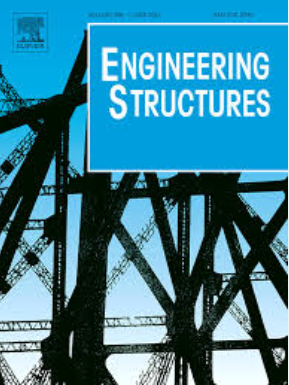新型全尺寸螺旋形潮汐涡轮机翼型的先进结构试验与建模
IF 6.4
1区 工程技术
Q1 ENGINEERING, CIVIL
引用次数: 0
摘要
潮汐能的利用为可持续发电带来了巨大的希望,特别是在有潮汐能资源的地区。在此背景下,潮汐能部门的目标是为潮汐能场址和河流开发创新的潮汐能系统,以加强绿色发电,实现联合国的可持续发展目标。然而,确保潮汐能涡轮机部件的结构完整性,特别是叶片的结构完整性,是其有效运行的关键,因为叶片在决定系统的性能、寿命、可靠性和效率方面起着关键作用。因此,本研究旨在通过结构试验和数值模拟来评估5 m长横流螺旋潮汐涡轮翼型的结构完整性,该翼型具有1.8 m转子和三个翼型,设计产生40 kW。测试程序遵循DNVGL-ST-0164和IEC DTS 62600-3:2020标准,包括动态,静态,疲劳和剩余强度评估。与常用的水平轴潮汐涡轮机叶片相比,采用独特的测试装置和测试方案对这种创新的潮汐箔进行了结构测试。在测试过程中,箔片经历了130万次疲劳循环,这是在干燥实验室条件下潮汐涡轮机叶片上记录的最高疲劳循环次数,并且,在最后的静态测试阶段,箔片在理想满载条件下的110 %持续损坏。一个数值模型,基于有限元方法,箔已初步开发利用材料特性从测试券和数据表。然后利用测试后从箔片中提取的薄片获得的力学性能对该模型进行了改进,但两种模型仅观察到细微的差异。对所有试验结果的综合评估和选定的数值研究验证了潮汐翼的新设计,同时为加速潮汐涡轮叶片结构试验程序提供了知识库。本文还强调了现代工具的使用和测试方法的调整,以适应不同的设计变化,从而减轻未来潜在的低潮和河流部署的行业风险。本文章由计算机程序翻译,如有差异,请以英文原文为准。
Advanced structural testing and modelling of a novel full-scale helical shape tidal turbine foil
The utilisation of tidal energy holds significant promise for sustainable power generation, particularly in regions with tidal resources. In this context, tidal energy sector is targeting to develop innovative tidal energy systems for tidal potential sites and rivers to enhance the green power generation and achieve United Nation’s sustainable development goals. However, ensuring the structural integrity of tidal turbine components, particularly the blades, is key for their effective operation, as blades play a pivotal role in determining the system's performance, lifetime, reliability, and efficiency. Therefore, the research aims to assess the structural integrity of a 5 m long crossflow helical tidal turbine foil, featuring a 1.8 m rotor and three foils designed to generate 40 kW, through structural testing and numerical modelling. The testing procedures adhere to DNVGL-ST-0164 and IEC DTS 62600–3:2020 standards, encompassing dynamic, static, fatigue, and residual strength assessments. A unique testing set up and testing protocol were followed to undertake the structural testing program for this innovative tidal foil compared to the commonly used horizontal axis tidal turbine blades. During the testing programme, the foil underwent 1,300,000 fatigue cycles, which is the highest number of fatigue cycles recorded on a tidal turbine blade in dry laboratory conditions, and, in the final static testing stage, the foil sustained damage at 110 % of the idealised full loading condition. A numerical model, based on the finite element method, of the foil has been initially developed using material properties from test coupons and datasheets. This model was then improved by using the mechanical properties obtained from coupons extracted from the foil after testing, however only a slight difference in the two models was observed. A comprehensive assessment of all the test results and selected numerical studies validated the novel design of the tidal foil, while developing a knowledge base to accelerate the structural testing programs of tidal turbine blades, has been presented. This paper also highlights the utilisation of modern tools and adaptations in testing methodologies to accommodate diverse design variations, thus mitigating industry risks for potential low tide and river deployments in the future.
求助全文
通过发布文献求助,成功后即可免费获取论文全文。
去求助
来源期刊

Engineering Structures
工程技术-工程:土木
CiteScore
10.20
自引率
14.50%
发文量
1385
审稿时长
67 days
期刊介绍:
Engineering Structures provides a forum for a broad blend of scientific and technical papers to reflect the evolving needs of the structural engineering and structural mechanics communities. Particularly welcome are contributions dealing with applications of structural engineering and mechanics principles in all areas of technology. The journal aspires to a broad and integrated coverage of the effects of dynamic loadings and of the modelling techniques whereby the structural response to these loadings may be computed.
The scope of Engineering Structures encompasses, but is not restricted to, the following areas: infrastructure engineering; earthquake engineering; structure-fluid-soil interaction; wind engineering; fire engineering; blast engineering; structural reliability/stability; life assessment/integrity; structural health monitoring; multi-hazard engineering; structural dynamics; optimization; expert systems; experimental modelling; performance-based design; multiscale analysis; value engineering.
Topics of interest include: tall buildings; innovative structures; environmentally responsive structures; bridges; stadiums; commercial and public buildings; transmission towers; television and telecommunication masts; foldable structures; cooling towers; plates and shells; suspension structures; protective structures; smart structures; nuclear reactors; dams; pressure vessels; pipelines; tunnels.
Engineering Structures also publishes review articles, short communications and discussions, book reviews, and a diary on international events related to any aspect of structural engineering.
 求助内容:
求助内容: 应助结果提醒方式:
应助结果提醒方式:


